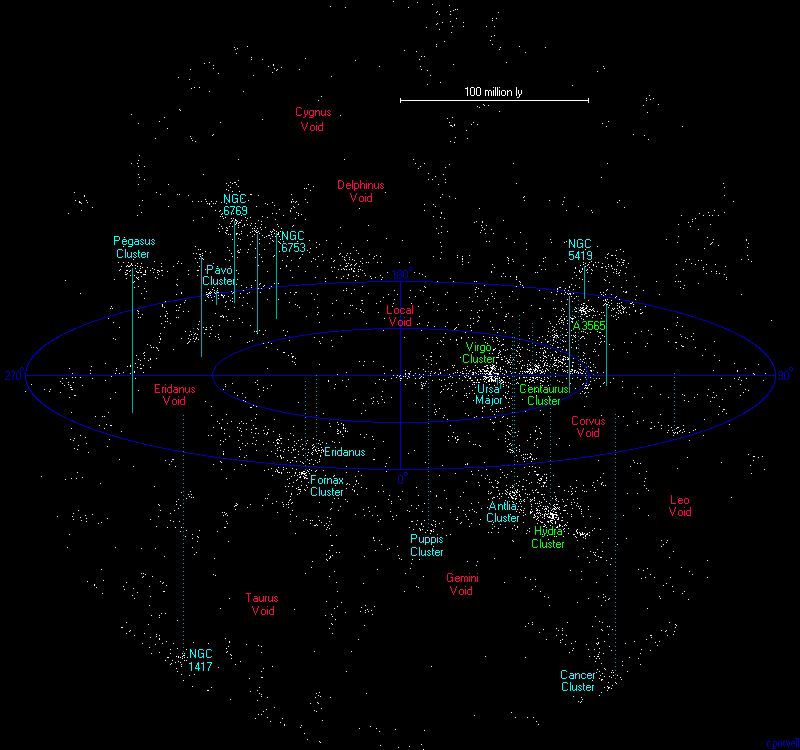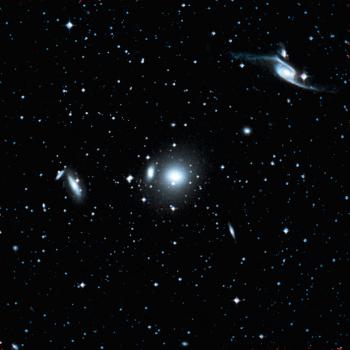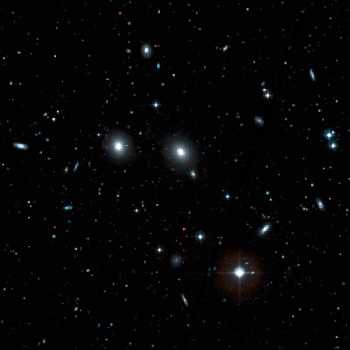
This drawing shows the distribution of galaxies within 200 million light years. It shows the region of space surrounding the Virgo supercluster. The dominant supercluster within this region is the Centaurus supercluster seen stretching away from the Virgo supercluster. The Centaurus supercluster is named after the large Centaurus cluster (A3526) although only the nearest half of the supercluster is shown on this map. Underneath the Virgo supercluster lies the Hydra supercluster named after the large Hydra cluster (A1060). On the left side of the map are some of the nearest galaxy groups in the Pavo-Indus supercluster most of which lies beyond the 200 million light year limit of this map. Several well-known voids are also marked on the map - these are regions where very few galaxies exist although none of the nearest voids are particularly large by cosmological standards. There is also a negative version of this map which might be easier to print.

This is a list of most of the large groups and clusters of galaxies within 200 million light years. The three dominant clusters are the Virgo, Centaurus and Hydra clusters. There is one other Abell cluster - A3565 - within this region although it does not seem to be very rich.
1 2 3 4 5 6 7 8 9
Name of Equatorial Supergalactic Number RV Distance Supercluster
Group Coordinates Coordinates of (km/s) (Mly) Membership
RA(2000)Dec L° B° Galaxies
Virgo I 12 30 +11.5 103.7 -2.8 100 960 50 Virgo
Ursa Major S 12 05 +45.0 70.2 +2.5 15 890 55 Virgo
Ursa Major N 11 50 +52.0 62.7 +2.7 20 1060 60 Virgo
Fornax I 03 35 -35.0 263.3 -41.5 40 1420 60
Eridanus 03 36 -22.0 280.8 -42.7 30 1550 70
NGC4697 12 55 -06.6 122.8 -1.8 15 1200 70 Virgo
Puppis 08 00 -27.0 155.9 -71.2 40 2100 95
Virgo M 12 24 +14.0 100.9 -3.5 20 2240 105 Virgo
Virgo W 12 20 +06.0 108.3 -6.7 20 2290 105 Virgo
NGC5676/IC1029 14 33 +49.7 68.1 +27.7 15 2340 110
NGC5044 13 15 -16.5 133.7 +0.2 15 2510 115
NGC5371 13 52 +40.5 78.5 +20.9 20 2540 120
NGC3557 11 10 -37.5 151.1 -30.2 15 2660 125 Hydra
NGC7172/IC5156 22 02 -32.5 248.8 +24.3 15 2660 125 Pavo-Indus
Antlia 10 30 -34.5 148.3 -38.5 30 2830 130 Hydra
Telescopium 20 10 -48.3 220.0 +23.8 15 2840 130 Pavo-Indus
Centaurus/A3526 12 45 -41.0 156.0 -12.1 100 2990 140 Centaurus
ESO507-25 12 51 -26.5 141.9 -7.8 20 3040 140 Centaurus
NGC6753/IC4837A 19 10 -56.0 208.7 +18.2 25 3100 145 Pavo-Indus
NGC5011/5090 13 15 -43.5 159.7 -7.2 20 3180 150 Centaurus
NGC3801/3800 11 41 +17.5 94.1 -12.1 20 3230 150
IC5250/NGC7329 22 47 -65.0 227.5 -1.7 15 3230 150 Pavo-Indus
Hydra/A1060 10 37 -27.5 139.3 -37.5 100 3360 155 Hydra
A3565 13 34 -33.6 151.3 -0.8 40 3590 165 Centaurus
Pavo/NGC6876 20 18 -70.9 213.2 +2.4 20 3820 180 Pavo-Indus
Pegasus 23 20 +08.5 298.6 +25.1 30 3840 180
NGC6769/IC4845 19 19 -60.6 209.5 +13.5 30 4020 185 Pavo-Indus
NGC5419/5488 14 06 -33.7 153.7 +5.4 30 4030 190 Centaurus
NGC5152 13 27 -29.7 147.1 -1.0 20 4040 190 Centaurus
NGC1417 03 45 -04.6 305.0 -42.0 25 4050 190
Cancer 08 19 +21.5 56.0 -47.5 30 4250 200
NGC4709 12 49 -41.0 156.1 -11.3 40 4310 200 Centaurus
|
Column 1: The usual name(s) of the cluster.
Column 2: The Right Ascension in hours and minutes for epoch 2000.
Column 3: The declination in degrees and minutes for epoch 2000.
Column 4: The supergalactic longitude.
Column 5: The supergalactic latitude.
Column 6: The number of large galaxies in the cluster. This number is a very
rough estimate.
Column 7: The recessional velocity of the cluster.
Column 8: The approximate distance to the cluster in millions of light years.
Column 9: The supercluster that the cluster belongs to.
References:
Fouque P, Gourgoulhon E, Chamaraux P, Paturel G, (1992), Groups of Galaxies within
80 Mpc, Astron Astrophys Supp, 93, 211.
Garcia A, (1993), General study of group membership. II. Determination of nearby groups.
Astron Astrophys Supp, 100, 47.
Giuricin G, Marinoni C, Ceriani L, Pisani A, (2000), Nearby optical galaxies: selection
of the sample and identification of groups. Astrophys J, 543, 178.
There is a lot of uncertainty about the Puppis cluster. It is directly behind the plane of our Galaxy and it is very heavily obscured. It is not even certain whether there is an actual cluster there, although there are certainly galaxies in this region. If the Puppis cluster is an actual cluster then it is probably similar in size to the Fornax cluster and lies at a distance of slightly under 100 million light years.
The Cancer cluster, on the other hand, probably doesn't exist at all - careful studies of the galaxies in this region show that the cluster probably consists of several smaller groups of galaxies lying close to each other.
 |
 |